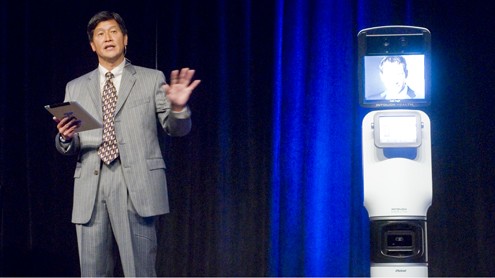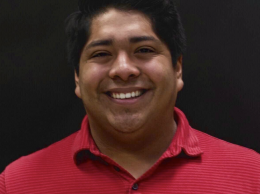Point and Go: InTouch rolls out self-guided medical robots

InTouch Health CEO Yulung Wang demonstrates the comapny's new collaboration with iRobot, a telemedicine robot that can find its own way around hospitals. (Stephen Nellis photo)
Goleta-based InTouch Health has unveiled a new medical assistant robot that can find its own way around a hospital with the tap of a finger an on iPad.
The new robot, called the RP-VITA, introduces what’s called autonomous navigation to the InTouch lineup. It is the first fruit of a yearlong collaboration with iRobot Corp., a publicly traded Massachusetts firm that makes the Roomba vacuum cleaner for consumers and a range of robots that have been used to defuse explosives in Iraq and clean up ruined nuclear reactors in Japan. The East Coast firm invested $6 million in InTouch earlier this year.
The new robot includes an iPad interface and secure networking technology. A faraway doctor can simply tap a patient’s name or room number on a hospital map, and the robot makes its way to the patient without help and pulls up clinical data for the doctor to assess.
High-resolution audio and video and laser pointers allow the doctor to examine the patient remotely. At an Apple-style keynote on July 27 at the Fess Parker DoubleTree in Santa Barbara, InTouch CEO Yulun Wang used the system to consult a stand-in patient at the company’s headquarters in Goleta, which includes a mockup of a hospital floor.
“This is probably the most state of the art robot ever put into the marketplace,” Wang told the audience of several hundred. “All you have to do is point and it will go there.”
Until the RP-VITA, InTouch’s robots still required human guidance to navigate hospital floors. Colin Angle, CEO of iRobot, said his company’s technology allows the robot to use a system of path-finding lasers and other devices to map out a hospital and then combines that with floor plans in the iPad interface. The robot can also stop quickly for hospital staff who move through its path and find alternate routes if the way is blocked.
“We’ve outfitted this robot with a web of sensors to help it make sense of its environment,” Angle said.
Both CEOs said the eventual goal of the robots is to diminish the barriers of time and space that result in an uneven quality of health care. Angle said the robots are aimed at “disrupting the entire notion of what it means to be somewhere.”










